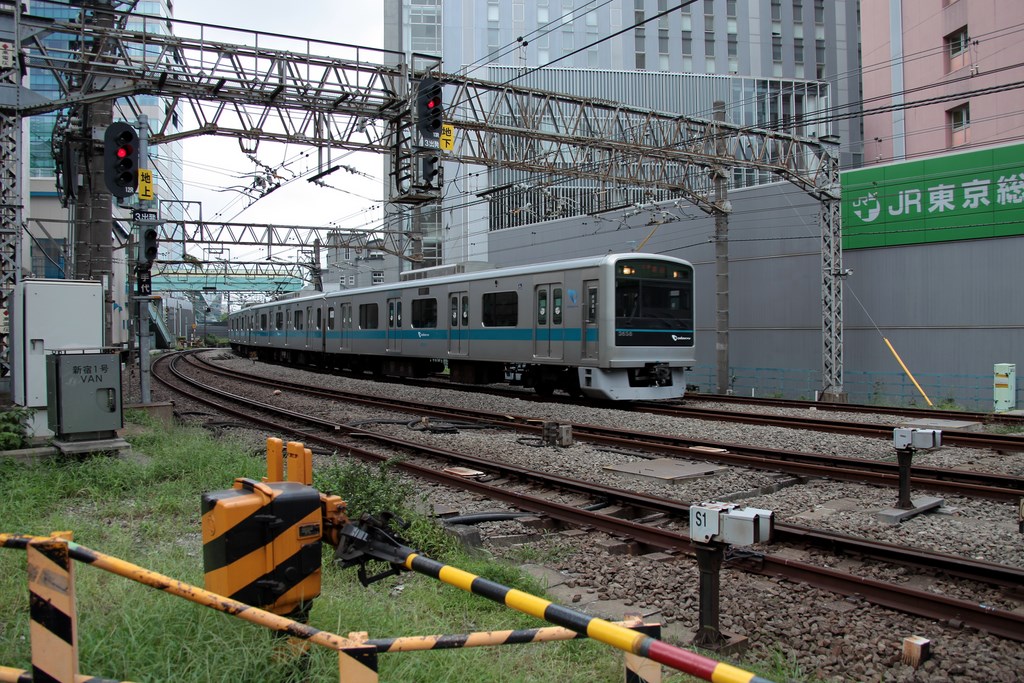ODAKUY ELECTRIC RAILWAY
La Odakyū Electric Railway Co., Ltd. (小田急電鉄株式会社, Odakyū Dentetsu Kabushiki-gaisha), communement appelée Odakyū, est une compagnie ferroviaire privée qui exploite des lignes ferroviaires dans l'ouest de Tokyo au Japon.
La compagnie Odakyū appartient au Groupe Odakyū, qui comprend 106 compagnies (au mois de janvier 2010) dont le chemin de fer électrique d'Enoshima, le réseau Hakone Tozan, les bus Odakyū, les grands magasins Odakyū et l'hôtel Hyatt Regency Tokyo. Le réseau se compose de 3 lignes qui s'articulent autour de la ligne Odawara.
Histoire
L’histoire de la compagnie Odakyū débute avec l’ouverture de la ligne Odawara entre Shinjuku et Odawara le 1er avril 1927.
- Le nom initial de la compagnie était le Chemin de fer express d’Odawara ( 小田原急行鉄道株式会社, Odawara Kyūkō Tetsudō Kabushiki-gaisha), abrégé Odawara Express (Odawara Kyūkō) puis simplement Odakyū. Cette dernière appellation devint le nom officiel de la compagnie en mars 1941.
- Le 1er avril 1929, la compagnie ouvrit une deuxième ligne, la ligne Enoshima.
- Le 1er mai 1942, Odakyū fût absorbée par la compagnie Tōkyū qui contrôlait alors l’ensemble du réseau ferroviaire privé du sud et de l’ouest de Tokyo. Odakyū regagna son indépendance le 1er juin 1948 et obtint une grande partie du réseau Hakone Tozan.
- En 1974, Odakyū compléta son réseau avec la ligne Tama pour desservir la ville nouvelle de Tama.
--------------------------------------------
Odakyu Electric Railway Co., Ltd. (小田急電鉄株式会社 Odakyū Dentetsu Kabushiki-gaisha), or OER, is a major railway company based in Tokyo, Japan, best known for its Romancecar series of limited express trains from Tokyo to Odawara, Enoshima, Tama New Town, and Hakone. The Odakyu Electric Railway forms the core of the Odakyu Group, which comprises 102 companies (as of August 1, 2012) and includes the Enoshima Electric Railway, Hakone Tozan Railway, Odakyu Bus, Odakyu Department Store, and Hyatt Regency Tokyo hotel.
History
The 83 km line from Shinjuku to Odawara opened for service on April 1, 1927. Unlike the Odawara line, rarely were pre-WWII Japanese private railways constructed with double-track and fully electrified from the first day of operation. Two years later, April 1, 1929, the Enoshima Line was added.
The original full name of the railroad was Odawara Express Railway Co., Ltd. (小田原急行鉄道株式会社 Odawara Kyūkō Tetsudō Kabushiki-gaisha), but this was often shortened to Odawara Kyūkō (Odawara Express). The abbreviation Odakyu was made popular by the title song of the 1929 movie Tokyo Kōshinkyoku and eventually became the official name of the railroad on March 1, 1941.
On May 1, 1942, Odakyu merged with the Tokyo-Yokohama Electric Railway company (now Tokyu Corporation), which controlled all private railway services west and south of Tokyo by the end of World War II. The company regained its independence on June 1, 1948, and it obtained a large amount of Hakone Tozan Railway stocks, instead of separating Keiō Inokashira Line for Keio Corporation. Odakyu restarted Non-stop Limited Express service between Shinjuku and Odawara in 1948. In 1950, Odakyu trains ran through to Hakone-Yumoto on Hakone Tozan Line. Odakyu uses narrow gauge (1,067 mm) tracks, but the Hakone Tozan Railway is standard gauge (1,435 mm), so one track of the section from Odawara to Hakone-Yumoto (6.1 km) was changed to a dual gauge system. Odakyu operated the first Romancecar (1710 series) limited express in 1951.
After the 1950s, due to rapid Japanese economic growth, Odakyu was faced with an explosive increase of population along with its lines. Commuter passengers had to use very crowded trains every morning, and complained strongly with the delay of improvements from the railway company. Odakyu began construction on the - "Shinjuku Station Great Improvement Project" setting 5 lines and 10 platforms long enough for 10 standard commuter cars with service on the Chiyoda Line, among others. Plans for a four-track system in 1964 were prevented by residents of Setagaya Ward in Tokyo, as such the system remains uncompleted. The Setagaya Residents' opposition set the stage for a long-term and remarkable case in the courts and legislature. Odakyu could not take main part of transport from Tama New Town Area, though Odakyu started the operation of Tama Line in 1974. To serve its Mukōgaoka-Yūen Amusement Park, Odakyu operated the Mukōgaoka-Yūen Monorail Line between Mukōgaoka-Yūen and Mukōgaoka-Yūen-Seimon (1.1 km, 2 stations) beginning in 1966 using a Lockheed Corporationstyle monorail system; the system was closed in 2001 when the amusement park was shut down.Odakyu 5000 series EMU near Mukōgaoka-Yūen StationSince 2000, Odakyū has been adding track in both directions from Izumi-Tamagawa Station, on Tama River, the border station of Tokyo, to just outside of Setagaya-Daita Station for expanding the availability of express trains, especially for morning commuter service. The lines between Setagaya-Daita and Higashi-Kitazawa Station are still under construction, however. Odakyu announced that the bottle-neck will be resolved by 2013.
With few exceptions, all of its lines are double- or quadruple-tracked, and its Odawara Line acts as a bypass route for the Tōkaidō Main Line from Tokyo to western Kanagawa. The Romancecar 3000 series "SE" was tested at speeds of up to 145 km/h in 1957, achieving a world record for narrow gauge (1067 mm) lines at the time. These tests also provided important data on high-speed electric multiple units (EMU), which Japanese National Railways (JNR) used for its limited express EMUs, 151 series, and 0 Series Shinkansen introduced in the early 1960s.
Odakyu celebrated its 80th anniversary in April 2007. The 50th anniversary of the Romancecar was celebrated in September 2007.
Odakyu are the current shirt sponsors of football club Machida Zelvia.
